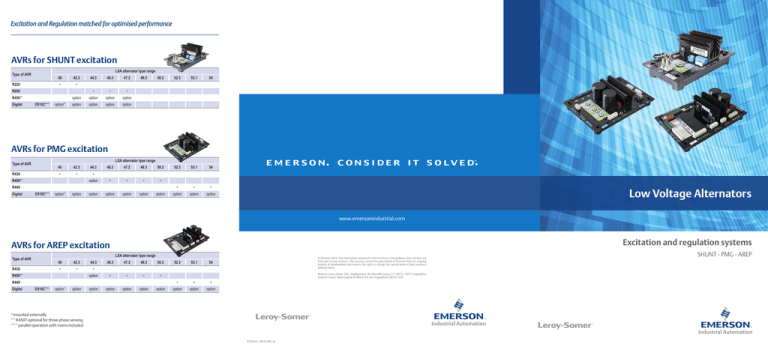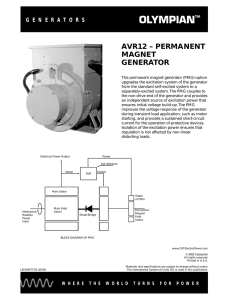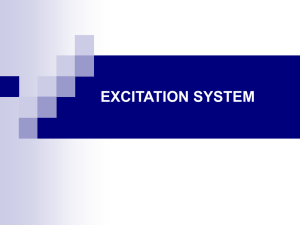SHUNT excitation
advertisement

Excitation and Regulation matched for optimised performance AVRs for SHUNT excitation LSA alternator type range Type of AVR R220 40 42.3 • • R250 R450** Digital D510C*** option* 44.3 46.3 47.2 • • • option option option option option option option option 49.3 50.2 52.3 53.1 54 52.3 53.1 54 • • • option option option AVRs for PMG excitation LSA alternator type range Type of AVR R438 40 42.3 44.3 • • • R450** option 46.3 47.2 49.3 50.2 • • • • R449 Digital D510C*** option* option option option option option option Low Voltage Alternators www.emersonindustrial.com Excitation and regulation systems AVRs for AREP excitation LSA alternator type range Type of AVR R438 40 42.3 44.3 • • • R450** option 46.3 47.2 49.3 50.2 • • • • R449 Digital D510C*** option* option option option option option option 52.3 53.1 © Emerson 2014. The information contained in this brochure is for guidance only and does not form part of any contract. The accuracy cannot be guaranteed as Emerson have an ongoing process of development and reserve the right to change the specification of their products without notice. 54 Moteurs Leroy-Somer SAS. Headquarters: Bd Marcellin Leroy, CS 10015, 16915 Angoulême Cedex 9, France. Share Capital: 65 800 512 €, RCS Angoulême 338 567 258. • • • option option option *mounted externally ** R450T optional for three-phase sensing *** parallel operation with mains included 4124 en - 2015.06 / d SHUNT - PMG - AREP Low Voltage Alternators - Excitation and regulation systems - The AVR power supply voltage is shunted on the alternator output terminals. - The voltage reference is shunted on the same output terminals. -The AVR generates and regulates the excitation current as a function of the alternator output voltage. The SHUNT system is extremely simple in its design and is ideal for basic applications. It cannot tolerate high overloads and does not offer a short-circuit capability. Excitation system selection chart SHUNT AREP SHUNT + PMG Motor starting capacity Basic High High Short-circuit capability No 300%/10 s 300%/10 s Susceptibility to non-linear loads Maximum Minimum Minimum Number of components Minimum Minimum Maximum Possibility of conversion Yes (PMG) Yes (PMG) Yes (Shunt) Alternator length Minimum Minimum Maximum Price € €€ €€€ Stator design Standard Special Standard Residual magnetism (remanent) Analog AVRs with digital regulation function Voltage build-up Residual magnetism (remanent) Permanent magnets Applications Basic backup Telecom Marine, industry, construction, hospitals, banks, standard production Marine, industry, construction, hospitals, banks, standard production R200 range for SHUNT excitation: simplicity itself - Single-phase voltage sensing - Underspeed protection by U/f (R220) or U/f and LAM (R250) function Lifetime Optimal Optimal Reduced: an additional turning part PMG excitation for demanding applications The main alternator is the same design as that used with SHUNT excitation. -The AVR power supply voltage is generated by a permanent magnet generator (PMG) which is mounted on the shaft extension behind the alternator. The PMG delivers constant voltage which is independent of the main alternator winding. - The voltage reference is shunted on the alternator output terminals. Whatever the load, the AVR therefore delivers an excitation current suitable for this load, depending on how the voltage reference changes. D500 range for SHUNT, PMG and AREP excitation types: performance communication - EASYREGTM parameter-setting and supervision program with user-friendly interface - Single-phase or three-phase voltage sensing - Adjustable underspeed protection by adjustable U/f and LAM function - Stator overvoltage protection - Built-in parallel operation between alternators and with the mains - Communication : USB serial, proprietary CAN, J1939 CAN - Diodes detection fault Un Permanent voltage drop 90% AREP PMG NT U AREP excitation for demanding applications/Patented by Leroy-Somer 100% 200% 250% 300% Systems that help take account of load impact/load shedding are built into Leroy-Somer AVRs Load as a % U/f function - Load impacts taken into account - Instant response from the AVR below the underspeed threshold - Gradual voltage return to rated voltage 180% Low overload High overload - Short-circuit LSA alternator type range 40 42.3 44.3 46.3 47.2 SHUNT • • • • • AREP • • • • • • • • • • • • • • • • • • • option option option • • • • PMG PMI* 49.3 50.2 52.3 53.1 *For better voltage build-up, permanent magnets are inserted in the the exciter poles (standard in 50.2, 52.3, 53.1 and 54). 54 Transient voltage drop UN UN Max. speed drop fN (U/f) without LAM with LAM U/f Time 0 1s 2s 3s without LAM 0.8 0 1s 2s Time Voltage LAM 48 or 57.5 Hz 0 with LAM 0.9 P2 0.85 UN 0.9 0.8 Underspeed and LAM Voltage LAM function - Load Acceptance Module - Reduction in voltage drop and duration of speed variation of the diesel engine - Possible increase in the applied load for the same speed variation -Adaptive tuning LAM for load impacts > 60% Excitation system varies depending on the type of alternator Type of excitation R400 range for SHUNT, PMG and AREP excitation types: performance - Single-phase voltage sensing - Excitation ceiling setting - Underspeed protection by U/f and LAM function - Parallel operation between alternators with CT - Parallel operation with the mains with CT and R726 module - Three-phase sensing in R450T version or with R731 module -Overload protection with R450 version Digital AVRs SH This power supply to the AVR power circuit is independent of the voltage sensing measured on the alternator output terminals. Therefore, the excitation current delivered by the AVR to the alternator exciter is independent of any voltage distortions (harmonics) due to the load. The AREP system gives the alternator a high overload capacity (load impact or starting electric motors) and a short-circuit capability (300% - 10 s) in order to provide discriminating protection: the alternator with AREP excitation is shorter than the one with PMG excitation. It is particularly suitable for demanding applications. Leroy-Somer AVRs benefit from all Leroy-Somer’s experience in the electronics field. They have been designed to comply with market requirements in terms of characteristics, performance, conformity with standards and reliability. Their main characteristics are as follows: -Simple, user-friendly user interfaces -Power switching transistor offers an optimum response to interference generated by distorting loads -Voltage regulation ±0.5% in steady state with rapid response time (< 500 ms) -Optimised mechanical design for resistance to vibration and harsh environments, with coated electronic circuits -Conformity with IEC 60034-1 and UL 508 Voltage U (%) The PMG system therefore has a high overload capacity (load impact or starting electric motors) which can short-circuit (300% - 10 s) in order to provide discriminating protection: Voltage build-up is intrinsic because of the permanent magnets. It is particularly suitable for demanding applications. The PMG system improves the performance of a SHUNT system. The AVR power supply voltage comes from 2 independent auxiliary windings located in the main stator: - The voltage delivered by the first auxiliary winding H1 is proportional to the alternator output voltage (shunt characteristic). -The voltage delivered by the second auxiliary winding H3 is proportional to the current drawn by the alternator and is a function of the applied load (compound characteristic – booster effect). - The resulting phase-to-phase voltage supplies power to the AVR. Analog or digital voltage AVRs depending on customer requirements 50 or 60 Hz fC fN LAM Load on the shaft (kW) SHUNT excitation for basic applications 3s Comparison of U/f and LAM system performance 0 Variation in the load Load shedding due to LAM 1s 2s Time 3s



